PinotFile: 10.47 February 1, 2017
|
Big Basin Vineyards: Whole Cluster Goodness Again
The vineyards that Bradley works with are very close to the ocean and quite cool, yet he sees very good stem lignification. He has able to use up to 100% whole cluster without introducing astringent and green tannins into the wines. In the 2013 vintage reviewed last year at www.princeofpinot.com/article/1781/, Bradley pushed the use of whole cluster inclusion to 100% in some wines. In the 2014 vintage reviewed here, he was all in, with every Pinot Noir ferment 100% whole cluster.
Whole cluster fermentation refers to the fermentation of intact clusters of grapes as they are picked from the vine with no intervention of de-stemming machines leaving all berries and stems intact. Stems are often removed in Pinot Noir winemaking before fermentation since the stems have a high tannin content and when unripe, they can give green or vegetal adjuncts to a wine. The Burgundians practiced stem inclusion for centuries, as historically they had no de-stemmers. Today, many notable Burgundy Domaines continue to be advocates of whole cluster fermentation. The New World has largely gone to complete de-stemming or the inclusion of small amounts of whole clusters. Chemically, when you include whole clusters in wine, you increase the pH and decrease the TA compared to a completely de-stemmed wine. The implication of this is that you may need to acidify the wine unless you are comfortable with high pH. Whole cluster also adds a dimension of carbonic maceration (intra-berry fermentation) leading to the characteristic rose petal aromatic. Proponents of whole cluster fermentation point out a number of advantageous features in the resulting wines. Aromatics can be fresher, more complex and literally thrilling, with aromas ranging from vegetal to exotic spices, rose petal, pine sap and burnt tobacco layered over the fruit component. Aged Pinot Noir made with whole cluster inclusion tends to be more aromatically complex compared to the same wine that is 100% de-stemmed. Stems also add the same dramatic effects on flavors. The tannic impression of a wine on the palate is altered as well and often a desirable silky softness occur. This is in part due to the prevention of harsh seed tannin from being released since the grapes remain encapsulated longer. Stem inclusion brings fragrance, intrigue, textural interest and even enhanced age ability. Winemaker Jeff Fink told me, “I am a big fan of the things that whole cluster fermentation can bring to the finished wine. The aromatics can be thrilling and literally spine tingling. Most Pinot Noir is lacking in the aromatics. It is the hardest component of Pinot Noir to capture.” Naysayers would add that stem inclusion produces a very stylized wine with the whole cluster character dominating any terroir character. On the other hand, it can be argued that Pinot Noir vinified with whole cluster represent more of the site and are more natural and minimalist. There will always be an argument of whether stylistic practices such as stem inclusion mask terroir. Are you looking for other wineries using significant whole cluster inclusion in Pinot Noir? Consider some wines in California from Laetitia, Samsara, Brewer-Clifton, Domaine de la Côte, Sandhi, Calera, Kutch, Littorai, Rhys Vineyards, Windy Oaks Estate, and in Oregon from Cristom, Guillen and White Rose Estate.
Big Basin Vineyards was founded in 1998 on a historic site adjacent Big Basin Redwoods State Park. An Estate vineyard is CCOF Certified Organic and was planted in 2000 primarily to Rhone varieties. 2 acres of Pinot Noir, Swan and Mt. Eden selections, were budded over some of the Syrah and the first harvest will be 2016. A winery was completed on the site in 2003 where the original 1890s house and winery structure built by French immigrants burned down in the 1970s. Harvest dates in 2014 were some of the earliest on record for Big Basin’s vineyards, yet grapes were perfectly ripe even at very modest Brix levels. All wines are 100% whole cluster fermented, hand punched down and fermented with feral yeast. No additions, including acid, other than sulfur dioxide after secondary fermentation is completed.They were aged 15 months in French oak barrels and bottled unfined and unfiltered in January 2016. Because of the high amount of stem inclusion, Bradley notes that the wines tend to take longer to integrate and bounce back after bottling. I found that the wines were fine upon opening one year after bottling and continue to improve over the following two days when tasted from a previously opened and re-corked bottle. This is a sign of quality, balance and age ability. These wines are highly recommended if your Pinot Noir stylistic tastes include whole cluster fermentation. The whole cluster character that is prominent in young wines should continue to integrate over time in bottle.
2014 Big Basin Vineyards Coast Grade Vineyard Santa Cruz Mountains Pinot Noir 12.8% alc., 95 cases, allocated to mailing list. This vineyard, owned and farmed by multi-generation Santa Cruz Mountains farmer Jim Beuregard, is located in Bonny Doon, a few miles north of Santa Cruz, 3 miles inland from the Pacific Ocean at 1,300 feet elevation. A limestone quarry across the street hints at the geology below the vineyard surface (sandy loam over limestone base rock). Clone 115, six years of age. · Moderate reddish purple color in the glass. Intoxicating aromas of cherry, spice, pine sap, rose petal and burnt tobacco. Noticeable mid palate presence of middleweight cherry and red currant fruit flavors framed by modest tannins and a hint of oak. Juicy, with plenty of sweet red fruit tang, an overlay of stem and forest floor, intriguing textural interest, and a long finish. This wine shows the most whole cluster character of the 2014 Big Basin Pinot Noirs and may be overbearing unless you welcome this stylistic dimension. Score: 91
2014 Big Basin Vineyards Coastview Vineyard Monterey County Pinot Noir 13.6% alc., 100 cases, Allocated to mailing list. Vineyard is located in the Gabilan Mountains on the east side of the Salinas Valley, six miles south of Calera’s Mount Harlan AVA. Decomposed quartz and limestone over base rock. The vines, perched at 2,200 to 2,400 feet elevation, are 17 years old. Dijon 113, 114, 115, 667, 777, Pisoni and Swan selection. Vines are farmed organically. Aged 15 months in 75% new French oak barrels. · Moderate reddish purple color in the glass. Seductive aromas of black cherry, cardamom spice, and a hint of stem. Light to mid weight in style, yet highly flavorful, with well ripened flavors of plum, cherry and black raspberry accented with spice and forest floor. Intense mid palate audacity, carrying over to a generous cherry-driven finish. While the juicy acidity is nicely integrated, the tannins are a bit unwieldy at present (but will moderate with more time in bottle). The intriguing texture is hard to adequately describe. While tasting, I wanted to swallow this one. Score: 93
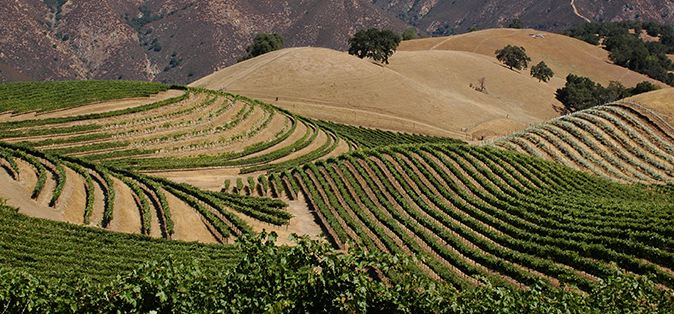
2014 Big Basin Vineyards Alfaro Family Vineyard Santa Cruz Mountains Pinot Noir 13.2% alc.,150 cases, $55. Vines are 15 years old. Clones 114, 115, 667 and 777 planted in sandy gravelly loam. · Moderately light cherry red color in the glass. Aromas of cherry, burnt tobacco, rose petal and spice pick up exuberance over time in the glass. Noticeable stem inclusion character which tended to integrate when tasted two days later from an opened bottle. Mid weight flavors of cherry and red berry with savory notes of burnt tobacco, spice and garden herbs. Silky in the mouth, with invisible tannins, admirable balance and some finishing intensity. A classy example of whole cluster goodness. Score: 93
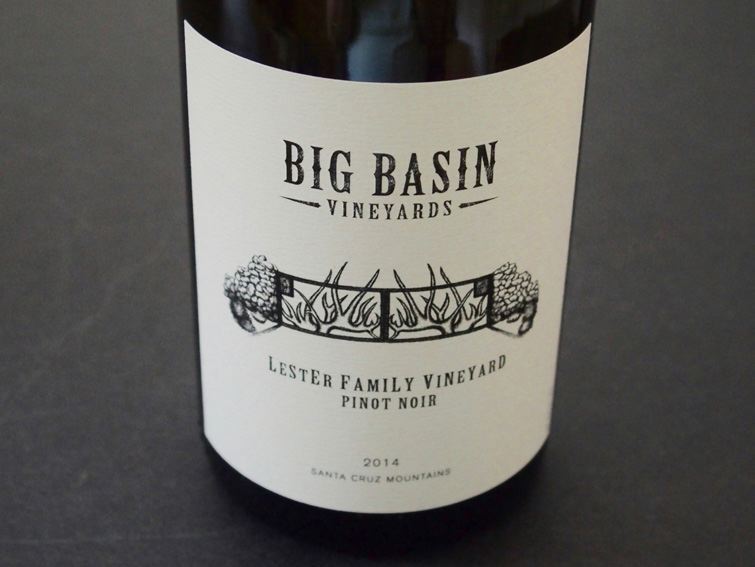 2014 Big Basin Vineyards Lester Family Vineyard Santa Cruz Mountains Pinot Noir 13.0% alc., 326 cases, $48. Very good stem lignification allowed 100% whole clusters. Tremendous color and flavor at low sugar levels. 16-year-old vines planted to Mt. Eden, 115 and 667. Soils are sandy loam over sedimentary base rock. · Moderate reddish purple color in the glass. This is a glorious wine in all respects. The whole cluster dimension is perfectly complimentary in this wine. Soaring aromas of cherry, rose petal and spice are harmonious. Silky in the mouth, with a deep spice-enhanced cherry and raspberry fruit flavor. Vibrant and refreshing, this wine soothes rather than attacks the palate. Very comforting with impeccable balance and a bombastic cherry finish. Even better when tasted two days later from a previously opened and recorked bottle. In one word, Wow! This wine really emotes. Score: 97
Big Basin Vineyards has two tasting rooms in the Santa Cruz Mountains: Saratoga Tasting Room at 14598 Big Basin Way in Saratoga (open Thursday-Monday) and at the Boulder Creek Winery at 830 Memory Lane in Boulder Creek (open Saturdays June-August and by appointment). The wines can be obtained through a mailing list, the winery’s wine club, and the website at www.bigbasinvineyards.com. The winery offers a full range of wines including Rosé, Pinot Noir, Rhone Red, Syrah and Chardonnay. Bradley is now producing more Pinot Noir than Syrah, becoming a major focus for him. Chardonnay is also an important varietal for Big Basin. One feature of the presentation worth noting is that the back label is very informative and succinctly contains all the important information about the wine in the bottle. This is an art that many producers fail to incorporate properly, preferring to use a lot of flowery praise about the wine without saying much.
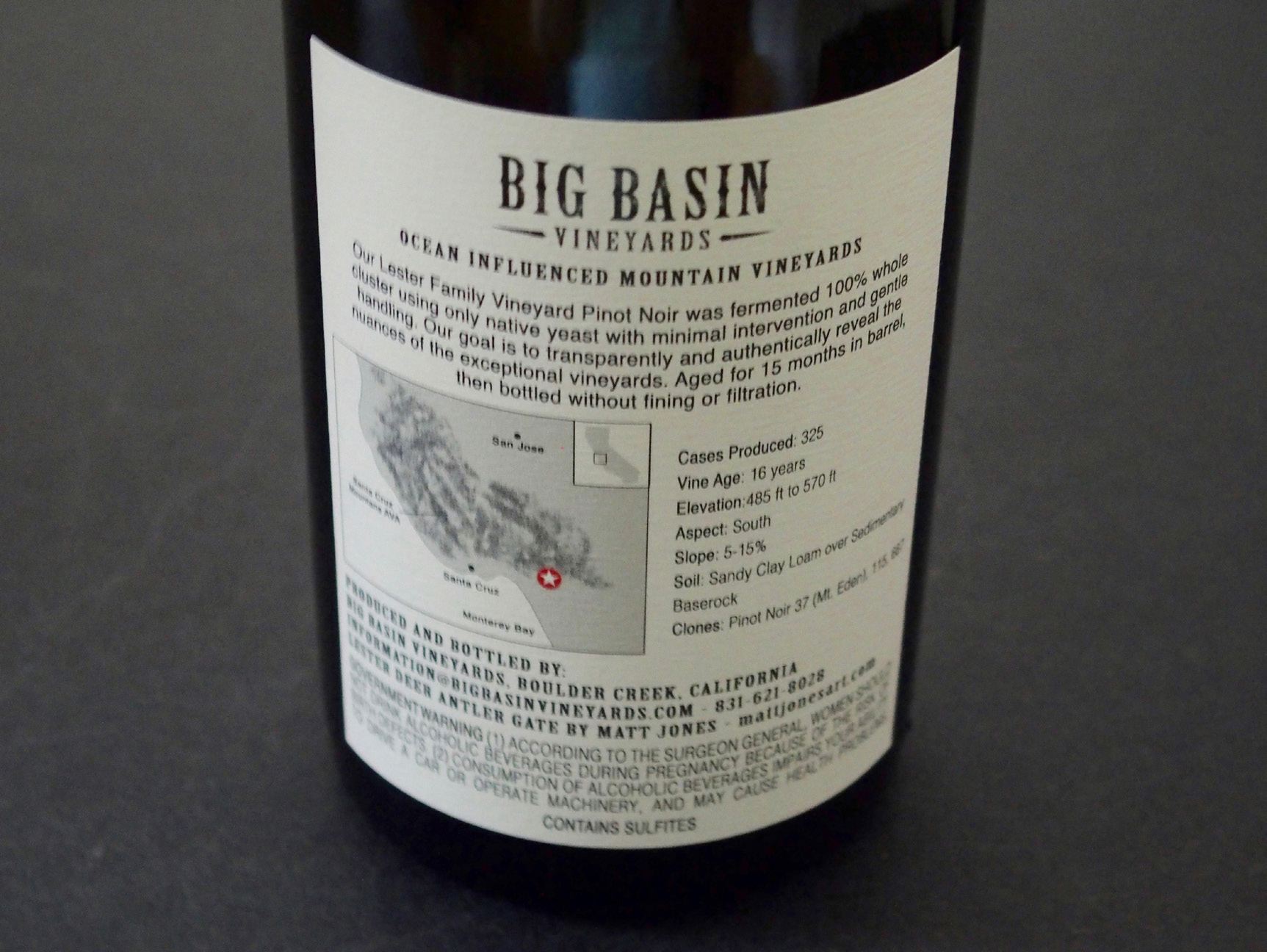
Square Peg Winery: Promising NewcomerSquare Peg Winery offers Pinot Noir from the estate and dry farmed SP-SL Vineyard located in the Russian River Valley adjacent Jim Riddle’s Riddle Ranch. This newer winery was not on my radar until my brother had a bottle of Square Peg Pinot Noir at a Christmas dinner and raved about it. I asked winegrower and winery owner Brad Alper about the story behind his winery and it turned out to be of great interest. The SP-SL (Square Peg-Stoetz Lane) Vineyard is pictured below.
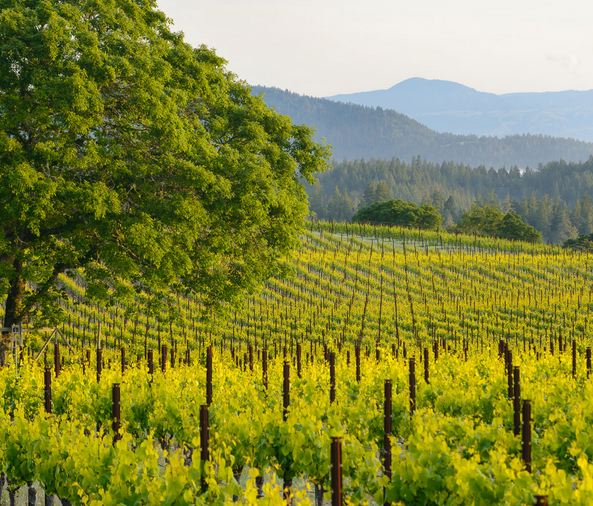 Along with his spouse, Alanna, Brad moved to the Russian River Valley in 1987 from Los Angeles where he had tired of city life. He was a pilot for American Airlines so it was convenient to drive to San Francisco Airport twice a week to fly his domestic trips. In 1994, he planted a 1-acre plot of Zinfandel. At the time, the only other wine grapes in the area were old vine Zinfandel at Dutton Ranch-Morelli Lane Vineyard and a small planting of Chardonnay nearby. In 1999, he bought a 12-acre apple orchard adjacent to his property, removed the decrepit trees, leased 5 acres to Dutton Ranch and planted the rest to Zinfandel. In 1999, Brad created the brand Ottimino devoted to Zinfandel and named in honor of his neighbor and local legend Ottimino Cristiani. Although relatively uninformed about the wine business, a series of fortuitous events led him to partner and build the brand with Jean Arnold Sessions, former CEO of Jackson Family Farms and President of Hanzell, and current President of Sonoma County Vintners, and Bill Knuttel, former winemaker at Saintsbury from 1983 to 1996, Chalk Hill from 1996 to 2003 and Dry Creek from 2003 to 2011. Jean was well connected in the wine business, so prior to launching Ottimino, she referred a number of people of some notoriety to discuss business possibilities. Brad was fortunate to meet and walk his site with Gary Farrell and Gil Nickel of Nickel & Nickel. At the time, he had know idea how well-known these two were, or even who Joseph Phelps who showed up with his son Bill and his winemaker Craig Williams early one morning to look at the site and discuss plans for a new brand. In 2011, Brad was preoccupied with his job, commuting to Los Angeles to fly 777s to London, Tokyo and Shanghai. The schedule was brutal and physically demanding. His vineyard and business coasted along, but he never put the effort in that was required to take them to the next level because financially he didn’t need to. One day, while flying back from London he had an epiphany. With eight hours left before the scheduled landing in Los Angeles, he was monitoring the airplane systems when he realized that this was how he was going to spend a majority of his life for the next thirteen years. He was making enough money, but it seemed he was wasting time and ultimately his life. Although he loved his job, it thought it was time for a change. At age 52, with over 28 years of flying with American Airlines, he decided to throw caution to the wind, retire early, and put all of his time and energy in to his vineyard and wine brands. He told me, “I would be lying to you, Rusty, if I said that I never once looked back or regretted my decision. It has been pretty scary at times, but there has been a lot of magic (like your brother trying our wine), and I am challenged every day. My life is much richer and I am a better person for sure.” How did he come to plant Pinot Noir? In 2010, Brad wanted to try to dry farm Pinot Noir, even though he was discouraged by all but Lynmar’s vineyard manager, Jason Saling. With his encouragement, Brad grafted a small section of his vineyard over to clone “828.” The quality of the fruit in the ensuing two years was very good but not of the caliber needed for a higher end Pinot Noir, so he sold the fruit. Realizing that he could dry farm Pinot Noir on his site, he budded over another section to Calera selection. The name of the winery, Square Peg, came to Alanna as the couple were bantering ideas back and forth, trying to come up with an easily remembered name but one that was not “overly mellifluous or trite.” It turns out, Square Peg is easy to recollect, people often think they have heard it before, and the name resonates with many because they have “always felt different like a Square Peg.” The inaugural Square Peg Pinot Noir in 2013 was produced from the first section of the vineyard that had been budded over to Pinot Noir (Block 8). In 2014, he harvested the Calera selection from Block 1 and “828” from Block 8. The 2014 Pinot Noir from Block 1 is 100% Calera and the 2014 Pinot Noir from Block 8 is about 80% “828” and 20% Calera. Oak regimen consists of 40% new Francois Frères barrels and the balance 2 and 3- year Francois Frères barrels, all with medium to medium plus toast. The wines are crafted by Bill Knuttel at his winery in Sonoma, a fortuitous relationship since Bill has been making wine for nearly 35 years and Brad considers his creativity and skill to be second to none. The potential for success of Square Peg is clear: uniquely dry farmed Pinot Noir grapes from a premier site in an ideal location put into the hands of an experienced and gifted winemaker. The area where SP-SL Vineyard is located is now highly regarded, among notable neighboring vineyards including Chenoweth Ranch, Riddle Ranch, CIRQ’s Treehouse, Aubert’s UV-SL, Dutton Ranch’s Morelli Lane, Fox Den, and Bill Price’s new vineyard at the top of Stoetz Lane. This area, just outside the town of Occidental, is under the radar but well known to Pinot Noir cognoscenti.
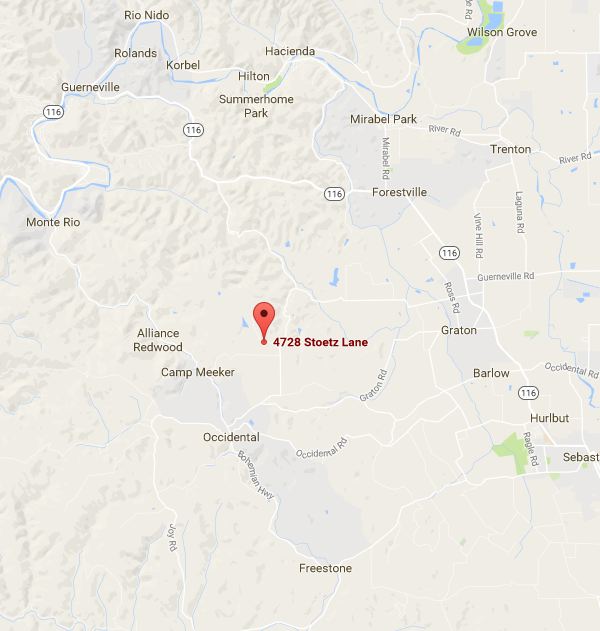 The wine has been placed in a few Northern California highly-regarded restaurants and the Alpers have opened a tasting room located in their vineyard in Sebastopol. Here they offer visitors a rich personal experience, an opportunity to picnic in the property’s serene Redwood Grove. In addition to pouring wine, the tasting room is also a fine art and sculpture gallery displaying Alanna’s work. The tasting room is open by appointment only. Zinfandel from the Ottimino brand as well as Chardonnay, Malbec and Cabernet from winemaker William, Knuttel are also featured in the tasting room.
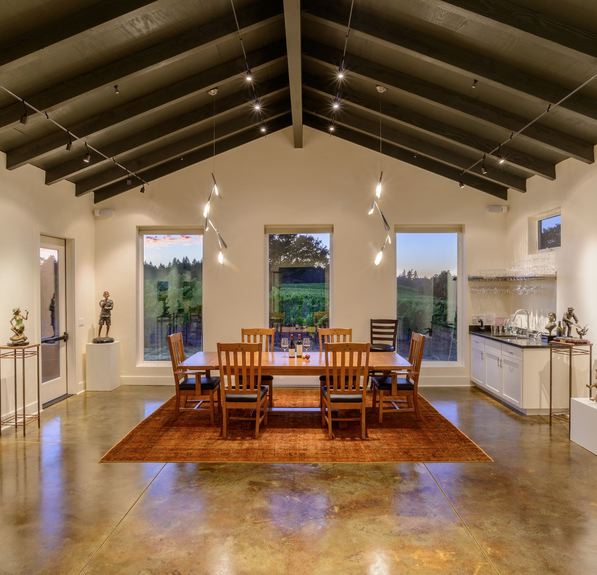 The small production Square Peg Russian River Valley Pinot Noir is allocated through a mailing list at www.squarepegwinery.com. The three wines reviewed here show the promise of this special property, and as additional experience is gained with the site and adaptive winemaking instituted, the Pinot Noir should reach a level of renown that will most probably make the Alpers gamble pay off. I have featured this winery not because of really high wine scores, but the realization that these wines will appeal to many consumers based on my experience. They are a a touch oaky for my personal taste, but still okey-dokey, because the fruit is of sterling quality. The wines reviewed here under went a 3-day cold soak after de-stemming. Following the completion of fermentation and extended maceration, the wines were aged in French oak barrels and bottled unfined and unfiltered.
2013 Square Peg SP-SL Vineyard Block 8 Russian River Valley Pinot Noir 14.5% alc., pH 3.70, TA 0.59, 224 cases, $55. Harvest Brix 24.8º. · Moderately light reddish purple color in the glass. The nose offers a nice blend of cherry fruit and savory notes of toast, spice, and wilted rose. Elegantly crafted, with a bright core of mid weight Bing cherry fruit framed by toasty oak and backed by silky tannins. Gorgeous essence of cherry fruit, but I wish the wine had slightly less oak influence. When tasted the following day from a previously opened and re-corked bottle, the nose was still captivating and the oak character had lessened. Score: 89
2014 Square Peg SP-SL Vineyard Block 1 Russian River Valley Pinot Noir 14.5% alc., pH 3.67, TA 0.56, 190 cases, $55. Harvest Brix 25.3º. 100% Calera selection. · Moderate reddish purple color in the glass. Aromas of toasty oak with demure notes of black cherry. Welcome charge of black cherry and black raspberry fruit mid weight flavors presented in a polished style with added accents of oak char, tea leaf, cola and spice. The oak is better integrated on the palate, the texture is quite silky, and the juicy finish attracts attention. Score: 90
2014 Square Peg SP-SL Vineyard Block 8 Russian River Valley Pinot Noir 14.5% alc., pH 3.60, TA 0.56, 170 cases, $55. Harvest Brix 24.2º. · Light reddish purple color in the glass. Opens with a heavy dose of cardamom, clove and toast aromas, transitioning over time in the glass to Bing cherry, tobacco leaf and spice. Mid weight in style, with a tasty core of fresh, even crunchy, black cherry fruit infused with a riff of smoke, toast and savory herbs. The wine sports easygoing fine-grain tannins, and noticeable length on the satisfying finish. When tasted the following day from a previously opened and re-corked bottle, the nose was still demurely perfumed with fruit and noticeably oak inspired, and the cherry and blueberry fruit flavors offered excellent vigor. Tasted twice. Score: 89
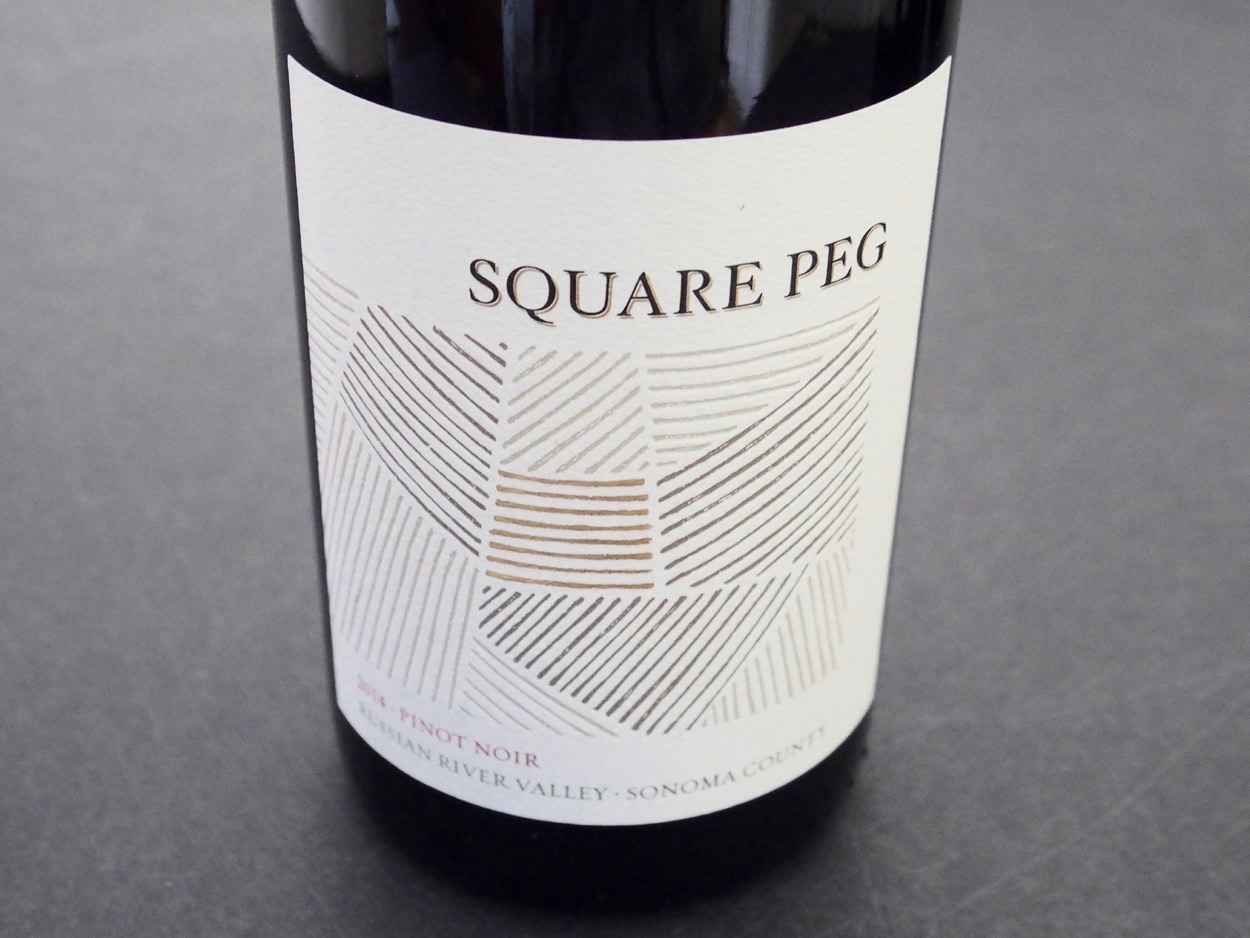
Sips of Recently Tasted Oregon Wines
Ayoub Vineyard & Winery, Dundee, OROwner Mo Ayoub produces Pinot Noir and Chardonnay from estate fruit and sourced grapes. The Ayoub Vineyard consists of 4 acres of Pinot Noir, clones 667, 777, 114, 115 and Pommard 4, planted in Jory soils in the Dundee Hills in 2001. The first release from the Ayoub Vineyard was 2004, and beginning in 2009, additional fruit was sourced to include Chardonnay and other Pinot Noirs in the lineup. A small winery was constructed on the Estate property in 2010 and completed in 2011. In recent years, the wines have been crafted with the assistance of veteran winemaker Robert Brittan. Production is less than 2,000 cases annually. I had seen glowing reviews in the wine press recently and acquired these bottles to review. Visit www.ayoubwines.com. In addition to the wines reviewed here, Pinot Noir from Overlook Vineyard, Brittan Vineyard and a single-barrel reserve, Latifeh, were offered. The wines are crafted in a very bold, sappy style in this vintage and are still tightly wound.
2014 Ayoub Memoirs Willamette Valley Pinot Noir 14.2% alc., $38. A blend of several select vineyards. Photo on front label was taken with winery owner Mo Ayoub, his father and siblings in 1964 on the beach in Beirut, Lebanon. Memoirs is a tribute to fond recollections of Mo Ayoub’s family. · Moderate reddish purple color in the glass. Nice harmonious blend of fruit and oak on the nose, with aromas of black cherry, black raspberry, mocha and vanilla. Good heft in a mid weight plus styled wine, with flavors of blueberry, black cherry and black raspberry framed by modest dusty tannins. Juicy, with a pleasing satin texture and a satisfying finish of good length. Still very appealing when tasted from a previously opened and re-corked bottle the following day. Score: 91-92
2014 Ayoub ??? Vineyard Dundee Hills Willamette Valley Pinot Noir 14.4% alc., 280 cases, $55. Fruit sources intentionally concealed but come from three highly-regarded vineyards in the Dundee Hills. · Moderately light reddish purple color in the glass. Aromas of dark chocolate coated black cherry, toast and underbrush. The core of sweet boysenberry and blueberry-pomegranate fruit flavors is quite generous, flooding the mouth with fruit goodness. The ripe fruit veers to compote and is backed by vigorous tannins. There is plenty to like in this wine, but it needs more time in bottle to fully integrate the tannins and shed some oak overlay. Still a bit tight when tasted the following day from a previously opened and re-corked bottle. Score: 88-90
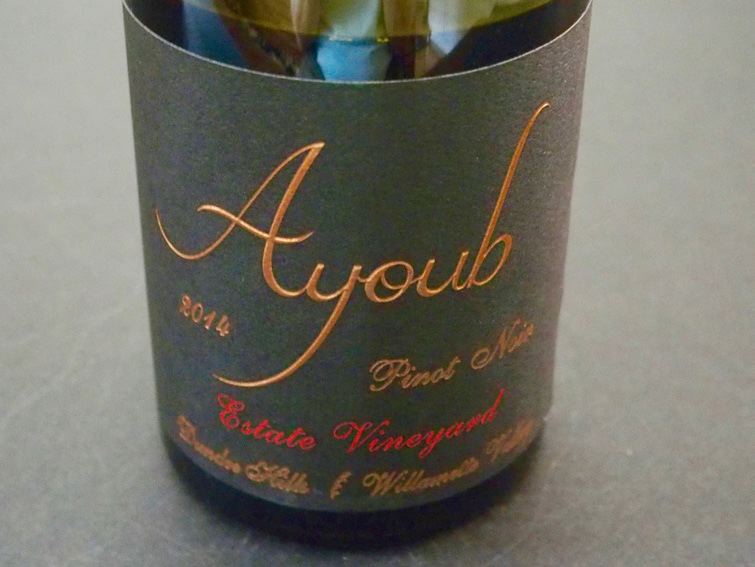 2014 Ayoub Estate Vineyard Dundee Hills Willamette Valley Pinot Noir 14.1% alc., pH 3.50, 440 cases, $60. · Moderately light reddish purple color in the glass. This wine is clearly an outstanding example of this vintage. Intoxicating aromas of black cherry, spice box, dark red rose petal and burnt tobacco. Revealing harmony with the first sip, this beauty is both elegant and silky on the palate, offering a mid weight array of black berry fruits supported by feathery tannins. Very giving at this early age. Even more striking the following day, when tasted from a previously opened and re-corked bottle, with an exuberant nose and enviable balance. Score: 93-94
Cristom Vineyards, Salem, ORIn the final issue of 2016, I raved about the 2014 Cristom single vineyard Pinot Noirs and two of them were Oregon All-Americans. Here are additional wines from the 2014 vintage. I try to keep my reviews limited to Pinot Noir and Chardonnay, but couldn’t curb my inquisitiveness for the other Cristom varietals. Visit www.cristomvineyards.com.
2014 Cristom Mt. Jefferson Cuvée Willamette Valley Pinot Noir 13.5% alc., $30. Named after the second tallest peak in Oregon that was named in honor of President Thomas Jefferson, a personal hero of both Cristom founder Paul Gerrie and winemaker Steve Doerner. Made from a blend of grapes from each of the estate vineyards along with fruit sourced from neighboring vineyards. Stylistically consistent. Whole cluster fermentations with native yeast followed by 12 months aging in French oak barrels. Unfiltered. · Moderately light cherry red color in the glass. Virtuous aromas of cherry, spice, rose petal and burnt tobacco. Light to mid weight in style, with bright flavors of red cherry, cranberry and red currant. Simple and straightforward in the characteristic Cristom style, with good attack, mouth presence, notable but silky tannins, and good intensity on the juicy finish. The most approachable Pinot Noir in the Cristom stable and an exceptional value. Score: 89
2014 Cristom Estate Eola-Amity Hills Willamette Valley Pinot Noir 13.0% alc., $50. A new bottling beginning in 2013 that represents the winemaker’s blend from the four single vineyard estate Pinot Noir sites. Whole cluster fermented with native yeast and extended aging in French oak barrels. Unfiltered. · Moderate reddish purple color in the glass. Aromas of cherry, red gumdrop, wilted rose and mulch lead off. Both savory and fruity, with a mid weight plus core of cherry, cranberry, spice, and herbal flavors. The fruit is less ripe in this bottling, offering a red spectrum, and is slightly tart. The tannins are well balanced, and the wine finishes with an acidic tang. Score: 90
2014 Cristom Estate Eola-Amity Hills Willamette Valley Syrah 14.5% alc., 251 cases, $50. Sourced from 1.25 acres of estate Syrah, planted in 2001 by grafting over Chardonnay. The vineyard is the warmest on the property. Four Syrah clones are picked separately and blended together. First bottled in 2003 when it was the first estate grown and bottled Syrah in the Willamette Valley. A rarity, since only about 32 acres of Syrah are planted in the Willamette Valley. · Dark reddish purple color in the glass. Aromas of blackberry compote, leather and tobacco lead to a middleweight style wine that drinks like a Pinot Noir. Flavors of blueberry and blackberry are strikingly glorious and nicely spiced with a peppery note. Balanced fine tannins make for easy approachability and my only nit is a hint of alcoholic warmth on the finish. A wine like this makes you think that Oregon should be doing more with Syrah crafted in a cool climate style. Score: 92
2015 Cristom Vineyards Eola-Amity Hills Willamette Valley Pinot Gris 14.0% alc., $20. Grapes planted in 1993, and this 5-acre vineyard is the only Cristom vineyard confined to sedimentary soils. Fermented in stainless steel tanks with no oak barrel exposure. The wine spends several months on its lees. · Light golden yellow color and clear in the glass. Nicely appointed aromas of citrus, spiced pear, honey, vanilla and flint. Slightly viscous on the palate, with appealing flavors of pear, apple, lime and honeydew melon. Bright, clean and very Alsatian in character. I never get particularly excited about Pinot Gris, but this one piqued my interest. Score: 92
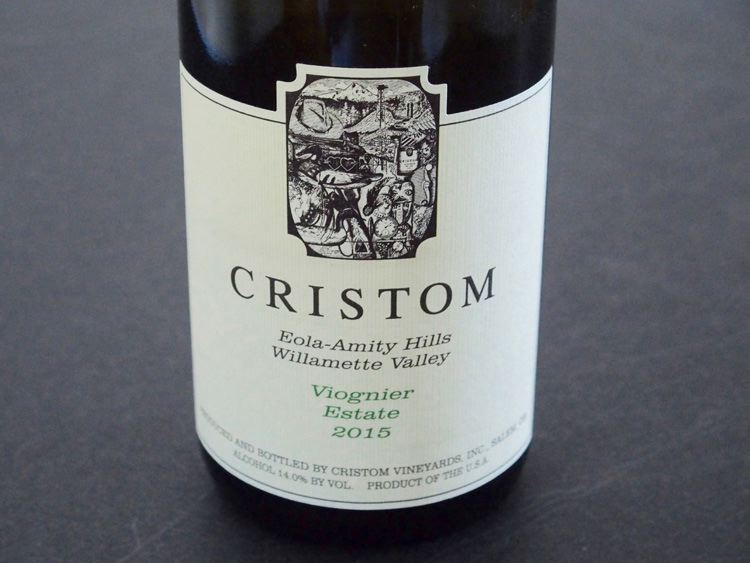 2015 Cristom Vineyards Eola-Amity Hills Willamette Valley Viognier 14.0% alc., pH 3.48, TA 0.58, RS 2.4 g/L, 674 cases, $30 1.25 acres planted on the estate in 1993 by Paul Gerrie, based on the success Cristom’s winemaker, Steve Doerner, had in California at Calera with this varietal. This 1993 planting was a pioneering first for the Willamette Valley as was the first estate release in 1996. The original vines are planted at high density of 2,311 vines per acre in Columbia River basalt soils. Between 2003 and 2010, Cristom planted and grafted just over 2.5 acres of young Viognier vines making the total block 3.744 acres. Fermented in a combination of neutral French oak barrels and stainless steel drums with 2/3 of the barrels fermented with native yeasts. partial malolactic fermentation, aged on its lees in barrel after partial malolactic fermentation for 9 months. Minimal effective additions of sulfur. Lightly fined and filtered. · Very light platinum color in the glass. Inviting aromas of jasmine and other white flowers, pear, peach and tropical fruits. Delicious flavors of pear, apricot and pastry cream, with a hint of tropical fruit and nuts. Slightly creamy in the mouth, with impeccable balance, finishing with a lingering and refreshing presence. One of the New World’s best examples of Viognier. Score: 93
Phelps Creek Vineyards, Hood River, ORIn 2014, bud break came very early and the season progressed rapidly due to a generous span of moderate heat. Heavy fruit set led to extra cluster thinning. Harvest was the earliest in the winery’s 24 years of growing vines. The wines are crafted by notable Burgundian, Alexandrine Roy, of Domaine Marc Roy, who travels to Oregon periodically to direct the vinification of Phelps Creek wines. Visit www.phelpscreekvineyards.com.
2014 Phelps Creek Vineyards “Corduroy” Columbia Gorge Pinot Noir Blanc 13.7% alc., 53 cases, $59. Dijon 115 from the Homestead Block in the Estate vineyard, as the first and highest acid pick of the season. Harvest Brix 23.3º. Fermented in oak barrel, 50% new, on the lees with battonage as needed. · Very light white pear color in the glass. Aromas of cut apple, pear, melon and warm waffle are fresh and appealing. Sleek on the palate with good verve, offering flavors of pear, melon, lychee, nutty oak, lees, and even a bit of lemon-lime that shows up on the finish. Easy to like, with a good cut of acidity on the finish and some length of appeal as well. The flavor profile is similar to Pinot Noir’s white brethren, Pinot Gris. One of the best examples of Pinot Noir Blanc from Oregon. Score: 90
2014 Phelps Creek Vineyards Columbia Gorge Pinot Noir 13.5% alc., 892 cases, $34. Estate grown Pommard, 115 and 777 clones. Barrel aged in French oak, 15% new. · Moderately light reddish purple color in the glass. This is an embracing wine, offering aromas of black cherry, raspberry, clove and burnt tobacco. Medium bodied, with noticeable depth of black cherry essence making an impression on the mid palate and finish. Lifted and lively, with a silky texture and supportive toasty oak, this refreshing wine offers immediate gratification but has enough backbone to please for several years. Score: 90
2014 Phelps Creek Vineyards “Beehive” Columbia Gorge Pinot Noir 13.9% alc., 117 cases, $38. Estate grown. Sourced from Dijon 777 block that was originally home to abandoned beekeeper boxes before vines were planted. Aged 20 months in French oak barrels, 20% new, 80% second-use. · Moderate reddish purple color in the glass. Intriguing aromas of black cherry, cola, spice and forest floor hold up majestically over considerable time in the glass. Flat-out delicious and very showy, with a mid weight plus core of black cherry, spice, dark chocolate and cedar flavors. Both plush and smooth on the palate with balanced tannins, skillful oak management, and an incredibly glorious cherry finish. Even better when tasted several hours later from a previously opened and re-corked bottle. Enjoy this one for for its exuberant cherry fruit now. Score: 94
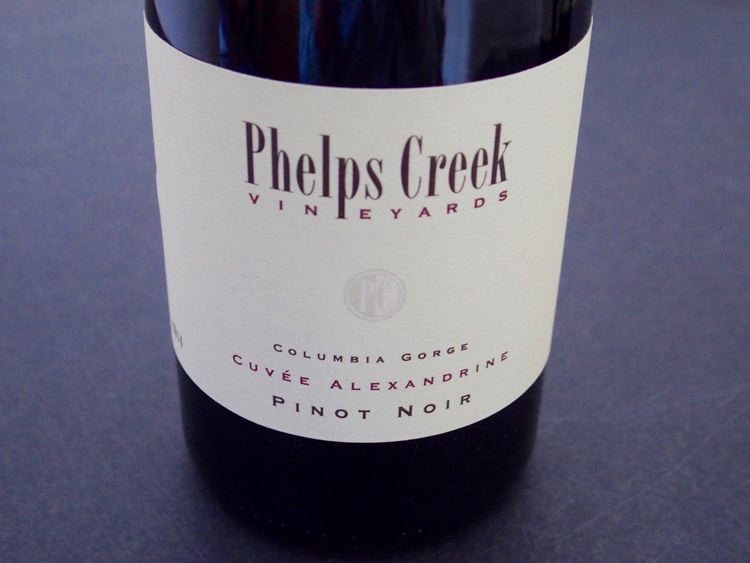 2014 Phelps Creek Vineyards “Cuvée Alexandrine” Columbia Gorge Pinot Noir 13.9% alc., 416 cases, $54. Winemaker Alexandrine Roy selected the finest 15 barrels of wines made from estate fruit in 2014 for this wine. Harvest Brix 23.8º. Clones are Pommard, 115 and 777. Native yeast fermentation. Aged in French oak barrels, 25% new. · Moderately light reddish purple color in the glass. The nose is remarkably complex, offering scents of dark red and black cherry and berry, rose petal, aged leather, and turned earth. A noticeable contrast to the “Beehive” bottling, with more structure, more savory and earthy facets, less flashy fruit, and slightly more oak contribution at this young age. A very sophisticated wine that is clearly built to age. The mid weight flavors of black raspberry and blackberry are set off by notes of spice and toast and emerge slowly in the glass over time. The finish is uncommonly generous as all great wines are. When tasted several hours later, the wine was more giving, indicating that it should be decanted if drunk now, but will benefit from more time in the cellar. Still evolving when tasted from an opened bottle two days later. Enjoy this one for its complexity and longevity. Score: 96
Winter’s Hill Vineyard, Dayton, ORThe Winter’s Hill Vineyard was planted by the Gladhart family on a 150-acre farm beginning in 1990. The initial 12 acres of Pinot Noir was own-rooted. In 1997, the family owners added a second phase of Pinot Noir planted on phylloxera resistant rootstocks. The vineyard now consists of 21 acres of Pinot Noir, clones 114, 115, Pommard and Wädenswil, and is LIVE and Salmon Safe certified (since 1999). Plantings of Pinot Gris and Pinot Blanc bring the total acreage to 35 acres. The vineyard is bordered to the East by Domaine Serene, to the South by Stoller Estate, and to the North by Vista Hills. A winery was completed on the estate in time for the 2009 vintage. Delphine Gladhart has been the winemaker since 2004. All wines are estate grown. Visit www.wintershillwine.com.
2015 Winter’s Hill Estate Watershed Dundee Hills Oregon Pinot Noir 13.5% alc., 1,500 cases, $25. Stemmed grapes were allowed to cold soak for 3 days before yeast inoculation. Aged 8 months in oak barrels. · Moderate reddish purple color in the glass. Discreetly concentrated, with cherry fruit at the core of the wine and a thread of leafy herbs in the background. There is compost and barnyard aromas upon opening with some fruit expression arriving later. The tannins are supportive, the acidity is brisk, and the herb infused cherry essence shows up on the finish with good intent. Score: 88
2014 Winter’s Hill Estate Dundee Hills Oregon Pinot Noir 13.1% alc., 143 cases, $39. Stemmed grapes underwent a 3-day cold soak before yeast inoculation. The wine was aged 16 months in oak barrels. · Light cherry red color in the glass. Aromas of cherry, cranberry, strawberry and green herbs lead to a light to mid weight styled wine with flavors that echo the aromas. There is more power than the color would suggest, and the polished texture makes for easy drinking. Very forward, with deft oak management, and well-proportioned tannins. Quite typical of the Dundee Hills in character. Score: 90
2014 Winter’s Hill Estate Block 1 Dundee Hills Oregon Pinot Noir 12.7% alc., 44 cases, $49. This bottling is part of the Single Block Series began in 2006. Block 1 is part of the original planting in 1990 and consists of own-rooted Pommard clone. It is at a lower elevation and easterly exposed so it is a cooler block that is usually the last block of Pinot Noir harvested. · Moderately light reddish purple color in the glass. Shy aromas of cherry, cranberry and turned soil. A solid, but somewhat lean wine with pleasurable cherry and blueberry flavors infused with a savory thread of herbs. Nicely composed with good harmony and noticeable acidic verve. Score: 88
2006 Winter’s Hill Vineyard Dundee Hills Oregon Pinot Noir 14.1% alc. Aged 11 months in French oak barrels. · Great color of moderate reddish purple. Aged nose, offering scents of must, marzipan, cigar, decayed stump, seasoned oak and medicinal awareness. Modest in weight, with flavors of black cherry, root beer and white pepper. The fruit still has good freshness and intensity. Nicely balanced, with good length on the fruit-driven finish. The tannins are noticeable yet find their place among the ripe fruit flavors that hold on to a finish that exposes a slight hint of alcoholic warmth. Drink up.
2005 Winter’s Hill Vineyard Reserve Dundee Hills Oregon Pinot Noir 13.5% alc., 146 cases. The best six barrels out of forty in the 2005 vintage. · Moderately dark reddish purple color in the glass. Aromas of cigar, old wood and leather vest lead off. More fruit expression on the palate, offering delicious mid weight flavors of black cherry fruit accented with brown spice and nutty oak. Surprisingly alert, lively and highly pleasurable, with modest tannins still in action. A terrific aged Pinot Noir that will please all pinotphiles. Drink now to 2020.
More Wines
2015 Broadley Vineyards Zenith Vineyard Eola-Amity Hills Willamette Valley Pinot Noir 13.5% alc., $30. One of the first 2014 Oregon Pinot Noirs I have reviewed. 30% whole cluster, aged one year in onceused French oak barrels. · Moderately dark reddish purple color in the glass. Lovely aromas of blackest cherry, dark rose petal, woodshed and nice barnyard. Impressive attack of black cherry fruit that sustains through the mid palate and finishes with a flourish. A little earthy and meaty with uplifting acidity. Structured, but not noticeably tannic. Still young, but like many ingenues, just starting to hint at predictable future success. Score: 92
2014 Dominio IV Rain on Leaves Stermer Vineyard Yamhill-Carlton Oregon Pinot Noir 13.8% alc., pH 3.65, TA 0.55, 148 cases, $36. Released November 2016. Vineyard is surrounded by old growth Douglas Fir trees. Willakenzie silty clay loam soil. Harvest Brix 24.4º. Clones 777, Pommard and Wädenswil. · Moderately dark reddish purple color in the glass. Shy, but very pleasing aromas of black cherry, spice and brioche. Very polished on the palate, in a mid weight plus style, offering delicious flavors of black raspberry, black cherry, plum and pomegranate. The wine has a strong backbone, yet the tannins seem to be fruit based and not bitter. The finish is notable for its generosity and glorious fruit persistence. This is quite an indulgent charmer and a great value to boot. Score: 93
Identifying Faults in Pinot Noir
A wine fault or wine defect is an unpleasant characteristic of a wine primarily due to by-products of normal fermentation and the winemaking process. In small amounts, the characteristic can be an asset to some imbibers, but in larger amounts it becomes an unpleasant fault. The term “flaw” is sometimes used interchangeably with the word fault, but a flaw is better considered a more minor unpleasant characteristic. Whether a wine is considered to have a flaw, or even worse, a fault, will depend somewhat on individual tolerance for the character. Unpleasant characters related to oxidation, reduction and sulfur dioxide often appear upon first opening a wine, but can dissipate or even disappear with exposure to air and swirling. A fault, however, will persist over time as an unfortunate component of the wine.
I have organized the most common unpleasant characters to ease identification and divided them into eight
categories. All categories are a by-product of fermentation or secondary to the winemaking process except
cork taint (listed last). At the end, I have simplified identification even further and you may want to print this out
for quick reference.
(1) Oxidation This class of aromas are consequences of fermentation, resulting from the oxidation of ethanol and bacteria (Acetobacter) interacting with acetic acid and ethanol (bacterial spoilage). They are referred to as volatile acidity (VA) or acescense. The aromas include acetaldehyde (rotten apples, bruised apple, dry straw, sherry, staleness, nuttiness, or cooked or stewed fruit), acetic acid (vinegar or Easter egg dye), and ethyl acetate (nail polish remover or acetone, glue, wood varnish, or paint thinner). A nutty, bruised apple aroma is only considered desirable in oxidative wine styles such as sherry. Volatile acidity is found more often with wild yeast fermentations and higher sugar levels because when sugars are high, yeasts may struggle, leading to a stressed fermentation and elevated VA. (2) Reduction Aromas of volatile sulfur compounds are produced by yeasts during fermentation, and include hydrogen sulfide (rotten eggs, cabbage, rubber, burnt rubber, cowpat, human fart, sewer, cooked veggies or roast coffee) and thiols known as mercaptans (onion, garlic, flint or rubber). Collectively, these aromas are known as “reduction” or “bottle stink.” (3) Sulfites Distinctive from sulfides, sulfites are by-products of sulfur dioxide added to wine as a preservative and antimicrobial agent and may produce aromas of sulfur, struck or burnt match, flint and burnt rubber. Often a trace of sulfur dioxide may be noticed in a newly bottled wine or in a wine upon first opening. Every wine label is required to have the words “Contains Sulfites,” unless no significant sulfur dioxide is used (less than 20 parts per million) in vinification and can be labeled as “Organic Wine” if grapes are also organically grown. (4) Yeasts The many compounds produced by the yeast Brettanomyces bruxellensis (Brett for short) and its relative, Dekkera bruxullensis, produce distinctive aromas in bottled wine. Brett contamination leads to four main by-products: esterases from degradation of fruity esters that leads to loss of fruitiness, volatile fatty acids including acetic acid and ethyl acetate (aromas of vinegar and or acetone), volatile phenols including 4-ethyl guaiacol (aromas of smoke, smoked bacon, creosote, burnt beans, strong spice, BBQ, clove, or burnt wood) and 4-ethyl phenol (aromas of horse sweat, sweaty horse blanket, horse stable, wet dog, barnyard, fecal, band-aid, antiseptic, or medicinal) and tetrahyropyridines (aromas of bread, popcorn or cracker in low concentration and mousy or horsy in high concentration. The volatile phenols are compounds only produced by Brett. Still other descriptors for Brett include wet wool, chicken droppings, gamey, funky sock, rotting vegetation and mouse case. Brett is more common in wines with higher pH, higher alcohol and minimal sulfur dioxide usage. (5) Guaiacol Aromas of wet ashtray, burnt meat and smoke derive from guaiacol in grapes exposed to smoke or in wines aged in toasted barrels. (6) Barrel Aromas of clove (eugenol), nutmeg, cinnamon, vanillin and coconut (lactones) can derive from oak barrels. Long barrel aging can lead to sotolone, an aromatic molecule in maple syrup, caramel, toasted nuts and soy sauce. (7) Diacetyl This organic compound has a IUPAC systemic name of butanedione and is a by-product of malolactic fermentation. It has a buttery aroma in low concentrations and an oil, nutty, butterscotch or caramel aroma in higher concentrations. (8) Fungus Cork taint is caused by the chemical compounds, 2,4,6-trichlororanisole (TCA) or 2,4,6-tribromoanisole (TBA) in a bottled wine, in many cases transferred from the cork. The compounds are a by-product of the interaction of some fungi with chlorinated phenolic compounds used in the processing of wood such as cork. This fault is not due to a natural fermentation by-product. Typical aromas include wet or moldy newspaper, wet dog, damp cloth or damp basement. Individual sensitivity to cork taint varies widely.
Faults at a Glance for Chemistry Averse Winos
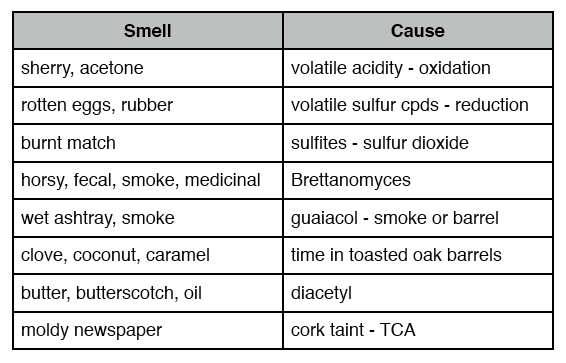
Pinot BriefsChapter 24 Acquires Witness Tree Vineyard Partners Mark Tarlov, formerly of Evening Land, and Burgundy’s Louis-Michel Liger-Belair, have bought the 100-acre Witness Tree Vineyard in the Eola-Amity Hills. Also, they acquired the 13-acre Black Walnut Vineyard in the Dundee Hills. Chapter 24 is planting another 30 acres at Witness Tree and will transfer all wine production to the Witness Tree property in time for the 2017 vintage. WillaKenzie Estate Hires Eric Kramer as Director of Winemaking Founded in 1992, WillaKenzie Estate produces Pinot Noir and Pinot Gris from estate and purchased grapes. The winery was named after the sedimentary soil on which the estate vineyards are planted. WillaKenzie Estate was acquired by Jackson Family Wines last year. Kramer has been crafting wine in the Willamette Valley for 13 years, most recently at Domaine Serene. Longtime assistant winemaker Michael Caputo and enologist David Mass remain a part of the WillaKenzie winemaking team. Sonoma County Barrel Auction Hosted by Sonoma County Vintners, this invite and trade-only event will take place on April 21, 2017. The Barrel Auction offers one-of-a-kind never-before and never-again lots representing Sonoma County’s diverse viticultural appellations. The wines for the Barrel Auction are chosen by an all-star panel of Master Sommeliers from around the country who assess the wines to ensure the highest quality, terroir authenticity and varietal correctness. The 2017 Barrel Auction is on pace to exceed last year’s offering of 75 small-lot wines. The selected auction lots will be previewed at Sonoma County AVA Association events on April 20, and auctioned the following day to select licensed wine sellers, including retailers, restaurateurs and wholesalers, invited personally by participating wineries. For further information, visit www.sonomacountyvintners.com. French Concerned About Drinking During Pregnancy Like in the U.S., wineries in France are required to print a health warning for pregnant women on the back of their wine bottles. The French Ministry of Health recently decreed that the pictograph show a pregnant women drinking from a glass inside a no symbol be increased in size to be more visible. About 1 in 1,000 infants are born with fetal alcohol syndrome in France. Drinking Socially is Good for Your Health. Recent research has shown something that will wine drinkers already know. Drinking wine in moderation with friends has undeniable health benefits. A study published in the journal, Adaptive Human Behavior and Physiology, looked at the benefits of alcohol consumption at pubs in strengthening social cohesion. The researchers pointed out that alcohol triggers the endorphin system, promoting social bonding, which in turn can affect how satisfied people are with their life. Winery & Vineyard Sell-off to Continue Elin McCoy wrote an article in BloombergPursuits, https://www.bloomberg.com/news/articles/2017-01-18/half-of-u-s-wineries-might-be-sold-in-the-next-five-years, with the heading, “Half of U.S. Wineries Might be Sold in the Next Five Years.” She points out that last year in California and Oregon, more than 35 “high-profile” wineries and vineyards were sold. Silicon Valley Bank’s State of the Wine Industry 2017 predicts continued sale of vineyard land this coming year. The report says that in a survey of U.S. winery owners, 30 percent were considering or expecting a sale during the next five years and an additional 20 percent said a sale during that time frame was possible. There are several reasons for this trend. Baby boomers are becoming older and want to retire and their offspring do not have interest in taking over the business. Buyers want prime land in areas where there are few plant able acres. Small brands have difficulty getting their wines in the retail marketplace and look to acquisition by bigger wine companies that have marketing and distribution muscle. Oregon is of prime interest now because top vineyards there cost one-tenth the price in Napa Valley. What impact this will have on the quality of the wines from wineries that have been acquired remains to be seen but it is worrisome that profit may be put ahead of character, individuality and pure genius that wines from small producers have to offer. Genetically Engineered Yeast Could Increase Wine Quality Researchers working at the University of Illinois College of Agricultural, Consumer and Environmental Services (ACES) claim to have produced a yeast that potentially could increase the quality of wine and also reduce wine’s hangover-inducing properties. Using a technique they called a “genome knife,” researchers could perform precise metabolic engineering on the yeast, Saccharomyces cerevisiae, commonly used in winemaking. It is conceivable, that with engineered yeast, the amount of resveratrol in a variety of wine could be increased by ten times or more, and malolactic fermentation could be improved while removing the toxic by-products that case hangovers. The research was recently published in the journal Applied and Environmental Microbiology. Comparative Growth of California Wine Regions Reported
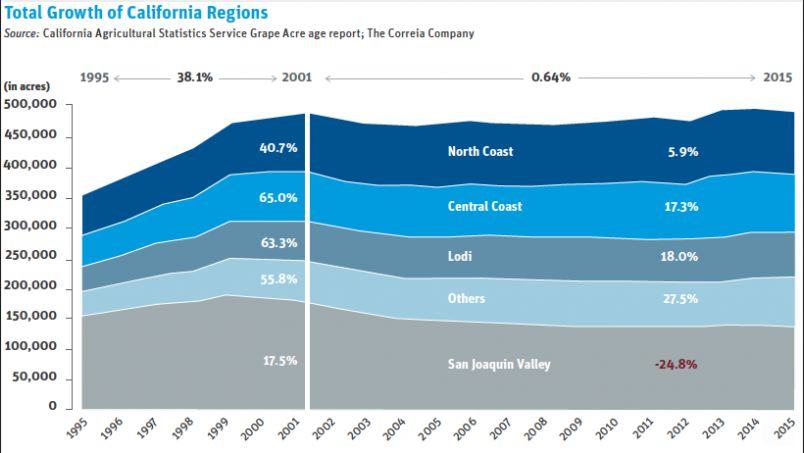 2016 Wine Sales and Case Growth
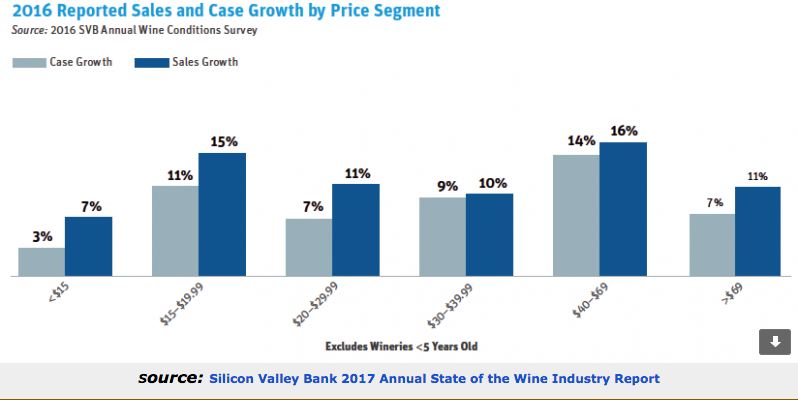 Vector for Red Blotch Found Last year, California researchers had a major breakthrough in the potential management of Red Blotch Associated Virus (RBaV). At least one vector, the three-cornered alfalfa treehopper, is now known for the disease but very little is understood about the feeding habits and biology of this pest. Greenhouse tests showed that the treehopper could transmit RBaV. Studies are continuing of other insect vector candidates as well. 14 year Degree Day Comparison Amalie Robert Estate in Willamette Valley This chart shows the comparative degree days recorded at the Amalie Robert Estate from 2003 to 2016 (thanks to owner Ernie Pink), and is a good indicator of the relative weather temperatures during the grape growing season. The findings should be generally comparable for other areas of the Willamette Valley.
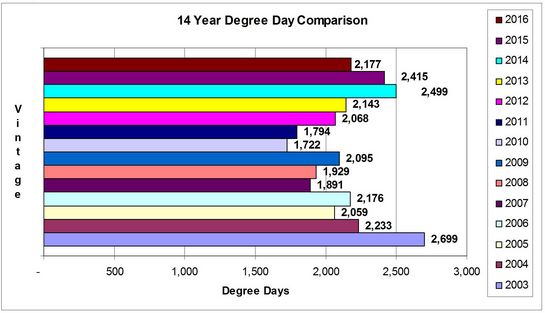 Oregon’s Vineyards Covered in Snow this Winter There is something eerily beautiful about vineyards with dormant vines covered in snow during winter. Oregon had more snow than usual the past several weeks and this made for spectacular photography. The photos below come from Saffron Fields Vineyard in the Yamhill-Carlton AVA (above, courtesy of Andrea Johnson) and the Luminous Vineyard also in the Yamhill-Carlton AVA.
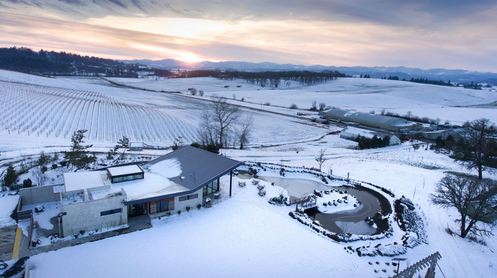
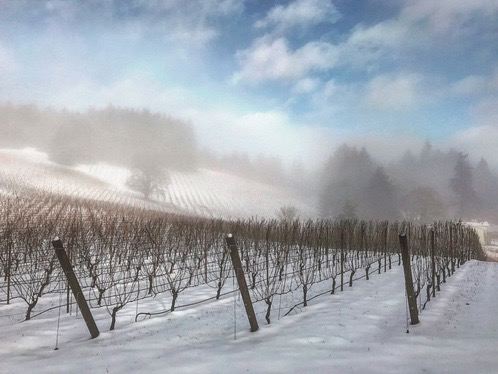 Steve Doerner’s Family Label Veteran winemaker Steve Doerner of Cristom Vineyards has released the second vintage of Pinot Noir under the Lucas Jefferson label. More details and a review of the wine will be upcoming in the next issue of the PinotFile. Record DTC Wine Shipments in 2016 A new report from Sovos ShipCompliant and Wines & Vines indicates that wineries sold more than 5 million cases (worth more than $2 billion) through direct shipments in 2016, a record increase in direct-to-consumer (DTC) shipments compared to 2015. Wine shipments outpaced retail sales growth by more than three-to-one in 2016. The increase reflects the popularity of wine ordering online and increased participation in wine clubs. 45 states and the District of Columbia allow direct wine sales. California is the leader in DTC orders, with nearly a third of all direct shipping orders.Shipments of wine priced under $15 per bottle grew faster than any other segment. Rosé Today Rosé Wine Today is holding two events: 2017 Competition for dry, a little sweet and sparkling rosés at Soda Rock Winery in Healdsburg March 22, 2017, and A Country Garden Party where the award-winning rosés from Rosé Today 2017 Competition will be celebrated on June 17, 2017, at Jaxon Keys Winery in Hopland. For information, visit www.rosewinetoday.com. Wine Stimulates Appetite Do you notice that when you drink a glass of wine before dinner your hunger increases? Research published in Nature Communications examined how alcohol affects the body, brain and actions of mice. The alcohol stimulated certain neurons, called AgRP, found in the hypothalamus, that increased appetite and decreased metabolism and energy levels. The researchers believe a similar reaction occurs in humans. New Wine Center for La Crema La Crema Estate at Saralee’s Vineyard in Windsor is a site to behold. The botanical wonders were planted by former owner Richard Knude who loved Butchart Gardens in British Columbia where he proposed to his spouse, Saralee. La Crema’s new tasting facility opened at Saralee’s Vineyard in August 2016. La Crema is part of Jackson Family Wines and bought the 200-acre estate from the Kundes in 2012. The main tasting room is in the Knude’s former house that was a restored barn first built in 1900. The tasting facility houses an impressive art collection that changes periodically. There are multiple tasting venues including an area on the second level with a tasting bar and seating, and in the back a main tasting bar and deck. Downstairs is a cellar where the winery’s limited production wines can be tasted by appointment. The third level is a wine club lounge. VIP tasting experiences are offered including Saralee’s Tasting Vineyard Tour, giving a personal look at the different grape varieties grown on the property, the botanical gardens and two lakes. The estate also has a pavilion, Richard’s Grove, for wine education seminars and community events. The estate will host the 2017 Sonoma Harvest Wine Auction in September. Visit www.lacrema.com/ russian-river-estate/.
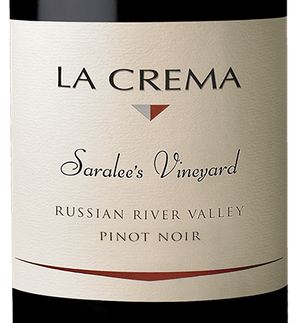 Oregon the Value-Priced Pinot King? Wine Spectator’s latest issue reports that 698 Pinot Noirs were tasted in 2016 by the magazine. Of these, only four value-priced PInot Noirs (priced at $30 or less) scored 90 or above. For Oregon, 838 wines were tasted (the number of Pinot Noirs was not broken out), 26 value-priced wines (priced $30 or less) scored 90 or above. Make what you want out of this, but I find very few Pinot Noirs from either state that are worthy of a score of 90 or above when priced $30 or under. If you know of any, I would be curious to learn about them. Winter Allocation Anxiety Over Pinot (WAAOP) WAAOP is a recently diagnosed psychiatric condition common among pinotphiles that is unresponsive to any treatment other than complete abstinence from winery mailing lists. It is brought on by the confluence of multiple notable domestic Pinot Noir producers announcing to their mailing list within days of each other the limited availability of upcoming fall releases. Anxiety in the sufferer begins a few days into the New Year and stretches over the month of January as the afflicted attempt to decide which allocations are really important. The onset is often at a time when wine lovers have just recovered from the wallet-busting days of Christmas and credit card statements are arriving in the mail. Wineries exacerbate the condition by warnings of impending catastrophe if you miss out by not acting quickly to insure your allocation. Worse yet, the winery may make it simple by allowing you to check the box that commits you to your entire allocation. The sufferer may be traumatized by the threat that if they fail to buy their allotment, their allocation may diminish or even worse, disappear. Those afflicted often retreat into their cellar, staring at racks of wine, trying to decide whether they really need more wine. Worse yet, they may question the need for their impending purchases with their spouse who, God forbid, may not share the same enthusiasm for Pinot Noir. Some have found comfort in Wine Clubs since they deliver wine regularly without the need to agonize over purchasing decisions. As a pimp of Pinot, I feel as if I have contributed to the prevalence of WAAOP, so I offer my wry condolences. More Humor A woman was married several times to men in the wine industry. Yet she remained a virgin. How could that be? Here was her explanation. My first husband was a winemaker and he kept promising me how good it was going to be if we waited a few more years. My second husband was a wine critic and just wanted to talk about it. My third husband was a professional wine taster and all he wanted to do was, well, you know. My fourth husband was a wine collector and he just wanted to look at it. My fifth husband was a wine marketer and although he had a nice product, he never knew how to position it. My sixth and last husband was a grape grower and he just wanted to stomp on me. (From Vintage Humor for Wine Lovers by Malcolm Kushner).
Two Good Reads for Wine Geeks
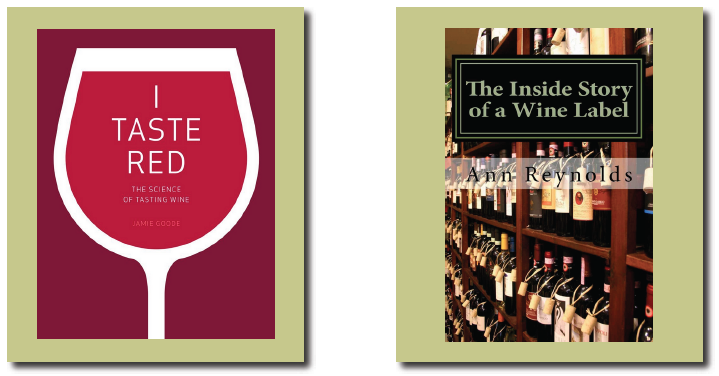
Jamie Goode is one of my favorite writers about the science of wine attributable to his knack of explaining complicated subjects in a simple to understand manner. That said, there will not be a vast number of people interested in reading 220 pages about the chemical senses, wine flavor chemistry, flavor perception, and approaches to wine tasting. As one who tastes wine frequently, however, I found the book enthralling and will put it close at hand for future reference. Goode is highly quotable and this excerpt from a discussion in the book about whether wine tasting is subjective or objective (or both) is a perfect example: “In conclusion, each person’s biology, knowledge, and prior experience are important factors in shaping their perception of flavor, suggesting that there is a strong subjective element in the activity....While there is a surprising amount of agreement on the (objective) taste of wine....there is still a degree to which consensus is just not possible.” Goode does not have all the answers to the questions he raises, but he is able to offer educated arguments that can give the reader valuable insight into the wine tasting process. I gobbled up the book in two days, and that should be a valuable recommendation for those inquisitive about reading this book.
Author Ann Reynolds has made a business out of helping wineries craft labels that tell the consumer all they need to know as well as being fully compliant with federal standards. In this brief, 75 page, soft cover book, Reynolds explains in detail all the required and non-required items seen on domestic wine labels. As she notes in the Introduction, “I’m on a mission to help consumers, connoisseurs and wine professional understand what goes on a wine label and why.” An example of the many subjects covered by Reynolds is the confusing terminology commonplace on back labels such as "blended," "cellared," "prepared", "produced," or "vinted" followed by “and bottled by.” Although important in making an informed wine purchase, few consumers understand what these phrases actually mean. You can breeze through this book in an hour or two and be entertained as well by favorite personal stories of the author from years of interacting with all the behind the scenes activities that lead up to a label being placed on a bottle of wine. This is another reference that I plan to keep close at hand. |